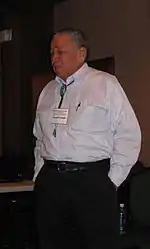基奧瓦人
基奧瓦(英語:Kiowa,/ˈkaɪəwə, -wɑː, -weɪ/)是美國大平原上的一個印第安人部落。17至18世紀,他們從蒙大拿州西部遷移到科羅拉多州,[2]19世紀進入南部平原。[3]
| 基奧瓦 Kiowa | |
|---|---|
 三個基奧瓦男性,1898年 | |
| 總人口 | |
| 12,000(2011年)[1] | |
| 分佈地區 | |
| 語言 | |
| 英語、基奧瓦語 | |
| 宗教信仰 | |
| 基督教、美洲原住民教會、傳統部落宗教 |
1867年,基奧瓦人搬到俄克拉荷馬州的保留區,現在被聯邦認可為俄克拉荷馬州基奧瓦部落(Kiowa Tribe of Oklahoma),2011年人口達12,000。[1]部落中心在俄克拉荷馬州卡內基。[1]現在仍然有說基奧瓦語的人,這種語言是基奧瓦-塔諾安語族的一個分支。[4]
語源學
基奧瓦人自稱Ka'igwu,意思是“最重要的人”。[2]古代名則是Kwu-da和Tep-da。後來又自稱Kom-pa-bianta,其意思與梯皮相關。另一個名字意思的可能來源是他們遷移時穿過了“基奧瓦山脈”(Kaui-kope),這座山脈位於現在美國蒙大拿州冰川國家公園。[5]
政府

J.T. Goombi,前基奧瓦部落主席及美國印第安人全國大會副會長
基奧瓦部落中心位於俄克拉荷馬州卡內基,其部落司法轄區包括卡多縣、科曼奇縣、卡頓縣 (奧克拉荷馬州)、格雷迪縣、凱厄瓦縣、蒂爾曼縣和沃希托縣。加入該部落需要至少四分之一的基奧瓦血統。[1]
基奧瓦人現在的商業委員會有以下職位有會長、副會長、秘書、會計和委員。[7]
文化
基奧瓦人是父系氏族,其酋長地位幾乎是永久性的。他們不是農業部落,故而需要通過貿易與其他部落交換糧食。
現在的基奧瓦人和平原阿帕奇人居住在科羅拉多州的阿肯色河西南部、堪薩斯州西部、德克薩斯州大草原區紅河附近及俄克拉荷馬州西部。[3]基奧瓦部落中的權力人物都是戰士,整個部落以他們為中心而建成。[9]
基奧瓦女性通過其男性家屬或自己的手工藝成就獲得社會地位。[10]
參考資料
- 2011 Oklahoma Indian Nations Pocket Pictorial Directory. 页面存档备份,存于 Oklahoma Indian Affairs Commission. 2011: 20. Retrieved 4 Jan 2012.
- Pritzker 326
- Kracht, Benjamin R. "Kiowa." 页面存档备份,存于 Oklahoma History Society's Encyclopedia of Oklahoma History and Culture. Retrieved 21 June 2012.
- "Kiowa Tanoan." 页面存档备份,存于 Ethnologue. Retrieved 21 June 2012.
- . [2013-01-28]. (原始内容存档于2012-05-06).
- Mithun, Marianne. First paperback. Cambridge, United Kingdom: Cambridge University Press. 2001: 441. ISBN 0-521-23228-7.
- "Kiowa Business Committee." 页面存档备份,存于 Kiowa Tribe. (retrieved 26 August 2011)
- "Kiowa Red River Casino." 页面存档备份,存于 500 Nations. Retrieved 4 Jan 2011.
- A History and Culture of the Southern Plains Tribes with an Introduction to the Study of North American Indians by Dick Swift, Carnegie Public Schools, 1972
- The Kiowa by U.S. Department of the Interior, Southern Plains Indian Museum, 1994
參考書目
- Dunn, Dorothy. American Indian Painting of the Southwest and Plains Areas. Albuquerque: University of New Mexico Press, 1968. ASIN B000X7A1T0.
- Greene, Candace S. Silver Horn: Master Illustrator of the Kiowas. Norman: University of Oklahoma Press, 2001. ISBN 0-8061-3307-4.
- Pritzker, Barry M. A Native American Encyclopedia: History, Culture, and Peoples. Oxford: Oxford University Press, 2000. ISBN 978-0-19-513877-1.
- Viola, Herman (1998). Warrior Artists: Historic Cheyenne and Kiowa Indian Ledger Art Drawn By Making Medicine and Zotom. National Geographic Society. ISBN 0-7922-7370-2
擴展閱讀
- Boyd, Maurice (1983). Kiowa Voices: Myths, Legends and Folktales. Texas Christian University Press. ISBN 0-912646-76-4.
- Corwin, Hugh (1958). The Kiowa Indians, their history and life stories.
- Hoig, Stan (2000). The Kiowas and the Legend of Kicking Bird. Boulder: The University Press of Colorado. ISBN 0-87081-564-4
- Mishkin, Bernard (1988). Rank and Warfare Among The Plains Indians. AMS Press. ISBN 0-404-62903-2.
- Nye, Colonel W.S. (1983). Carbine and Lance: The Story of Old Fort Sill. Norman: University of Oklahoma Press. ISBN 0-8061-1856-3.
- Momaday, N. Scott (1977). The Way to Rainy Mountain. University of New Mexico Press. ISBN 0-8263-0436-2.
- Richardson, Jane (1988). Law & Status Among the Kiowa Indians (American Ethnological Society Monographs; No 1). AMS Press. ISBN 0-404-62901-6.
- US Department of the Interior (1974). "The Kiowa". Southern Plains Indian Museum and Crafts Center.
- Walter Echo-Hawk, In the Courts of the Conqueror: The 10 Worst Indian Law Cases Ever Decided (2010).
This article is issued from Wikipedia. The text is licensed under Creative Commons - Attribution - Sharealike. Additional terms may apply for the media files.
